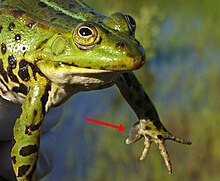Nuptial pad
A nuptial pad (also known as thumb pad, or nuptial excrescence[1]) is a thick piece of flesh on the front feet of some frogs and salamanders. Only adult male animals have this pad.[2][3][4][5]

The nuptial pad is a gland. It is a secondary sex characteristic. The male animals use the nuptual pad to hold on to females when they mate, but it does not make or move sperm itself.[6] Some animals use their nuptial pads to fight each other.[6]
Historical background
changeAustrian biologist Paul Kammerer looked at midwife toads' nuptial pads.[7] He believed in Lamarckian evolution. This means he thought that the male frogs' pads got bigger in their own lifetimes, and then they passed the big pads on to their young after that.[8] But this is not how evolution truly works.
Examples
changeMany amphibian species grow nuptial pads for mating. For example, the rough-skinned newt (Taricha granulosa) does.[9]
References
change- ↑ William E. Duellman; et al. (1994). Biology of Amphibians. JHU Press. p. 55. ISBN 978-0801847806.
- ↑ "Science & Nature – Wildfacts – Common frog, grass frog". BBC. 2008-07-25. Retrieved 2011-07-14.
- ↑ "Mertensiella caucasica". AmphibiaWeb. 1999-10-03. Retrieved 2011-07-14.
- ↑ "Ommatotriton ophryticus". AmphibiaWeb. 2005-10-26. Retrieved 2011-07-14.
- ↑ "Pleurodeles waltl". AmphibiaWeb. 2002-05-25. Retrieved 2011-07-14.
- ↑ 6.0 6.1 Herpetology (3rd ed.). Upper Saddle River, NJ: Pearson/Prentice Hall. 2004. pp. 67–68. ISBN 0-13-100849-8.
{{cite book}}: Unknown parameter|authors=ignored (help) - ↑ Koestler, Arthur (1971). The Case of the Midwife Toad. Random House.
- ↑ [1] Archived September 17, 2008, at the Wayback Machine
- ↑ C. Michael Hogan (2008). "Rough-skinned Newt (Taricha granulosa)". Globaltwitcher, ed. Nicklas Stromberg. Archived from the original on 2009-05-27.